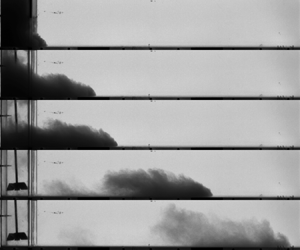Published online by Cambridge University Press: 23 October 2023

Most gravitational currents occur on sloping topographies, often in the presence of particles that can settle during the current propagation. Yet an exhaustive exploration of associated parameters in experimental studies is still lacking. Here, we present an extensive experimental investigation of the slumping regime of turbidity (particle-laden) currents in two lock-release (dam-break) systems with inclined bottoms. We identify three regimes controlled by the ratio between settling and current inertia. (i) For negligible settling, the turbidity current morphodynamics corresponds to that of saline homogeneous gravity currents, in terms of velocity, slumping (constant-velocity) regime duration and current morphology. (ii) For intermediate settling, the slumping regime duration decreases to become fully controlled by a particle settling characteristic time. (iii) When settling overcomes the current initial inertia, the slumping (constant-velocity) regime is no longer detected. In the first two regimes, the current velocity increases with the bottom slope, of approximately  $35\,\%$ between
$35\,\%$ between  $0^\circ$ and
$0^\circ$ and  $15^\circ$. Finally, our experiments show that the current propagates during the slumping regime with the same shape in the frame of the moving front. Strikingly, the current head is found to be independent of all experimental parameters covered in the present study. We also quantify water entrainment coefficients
$15^\circ$. Finally, our experiments show that the current propagates during the slumping regime with the same shape in the frame of the moving front. Strikingly, the current head is found to be independent of all experimental parameters covered in the present study. We also quantify water entrainment coefficients  $E$ and compare them with previous literature, hence finding that
$E$ and compare them with previous literature, hence finding that  $E$ increases rather linearly with the current Reynolds number.
$E$ increases rather linearly with the current Reynolds number.